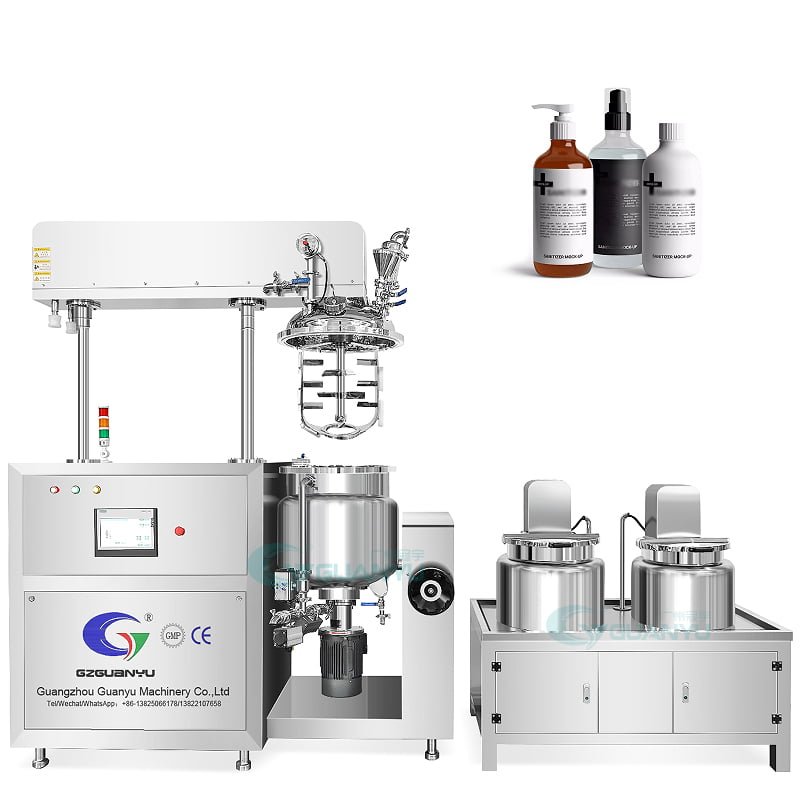在制药行业, 混合反应器, 也称为混合罐或搅拌容器, 是搅拌的必备设备, 溶解, 匀浆, 以及各种液体和半固体材料的加热/冷却. 这篇综合文章探讨了可以使用混合反应器生产的药品类型,并强调了它们在确保产品质量和一致性方面发挥的关键作用.
简介 混合反应器
混合反应器旨在促进在受控条件下混合成分. 它们由一个配备搅拌器或搅拌器的罐组成,可确保内容物彻底混合. 这些反应器用途广泛,可适应各种药品制造工艺, 从小规模实验室配方到大规模工业生产.

使用混合机生产的药品类型
1. 解决方案
混合反应器广泛用于药物溶液的生产. 这些包括:
- 口服溶液: 止咳糖浆和液体维生素等药物.
- 注射液: 注射用无菌溶液, 包括疫苗和抗生素.
- 局部解决方案: 外部应用,如抗菌溶液和滴眼剂.
混合反应器确保活性成分和赋形剂完全溶解, 产生清晰稳定的解决方案.
2. 暂停
悬浮液是液体制剂,含有细碎的, 分散在整个液相中的不溶性药物颗粒. 常见的例子包括:
- 抗生素混悬液: 用于口服给药, 特别是在儿科配方中.
- 抗酸混悬剂: 含有不溶性抗酸颗粒的液体.
混合反应器提供分散和维持颗粒悬浮所需的高剪切力, 防止沉淀并确保均匀性.
3. 乳液
乳液是两种不混溶液体的混合物, 例如油和水, 其中一种液体分散在另一种液体中. 药物乳液的例子包括:
- 外用霜剂和乳液: 用于皮肤治疗.
- 口服乳剂: 口服药物, 像某些维生素和营养补充剂.
混合反应器通过施加足够的剪切力将一种液相分散到另一种液相中,促进稳定乳液的形成.
4. 软膏和霜剂
软膏剂和霜剂是用于外用的半固体制剂. 他们包括:
- 药用软膏: 用于皮肤状况, 提供屏障并向受影响区域输送药物.
- 美容霜: 保湿霜和抗衰老霜.
混合反应器确保活性药物成分的均匀混合 (蜜蜂) 与基材, 产生一致且有效的产品.
5. 凝胶
凝胶是由分散在液体中的小分子或颗粒组成的半固体系统. 他们包括:
- 眼科凝胶: 用于眼部治疗, 提供持续的药物释放.
- 皮肤科凝胶: 用于皮肤状况, 以受控方式输送药物.
- 口服凝胶: 用于治疗口腔粘膜疾病.
混合反应器有助于凝胶形成剂和 API 的均匀分布, 确保产品的顺利和一致.
6. 糖浆
糖浆是糖的浓缩水溶液, 通常含有调味剂和 API. 由于其适口性,它们通常用于儿科医学. 例子包括:
- 感冒糖浆: 用于治疗咳嗽和感冒症状.
- 维生素糖浆: 儿童营养补充剂.
混合反应器对于溶解高浓度的糖并确保 API 和调味剂的均匀分布至关重要.
7. 注射液
注射溶液需要严格的无菌和均质性. 他们包括:
- 疫苗: 用于多种疾病的免疫接种.
- 抗生素注射液: 用于治疗严重感染.
配备无菌组件和精确控制机制的混合反应器确保生产安全有效的注射溶液.
8. 局部解决方案
将局部溶液涂在皮肤或粘膜上. 他们包括:
- 防腐解决方案: 用于伤口消毒.
- 抗真菌解决方案: 用于治疗真菌感染.
混合反应器提供必要的搅拌和温度控制,以产生稳定有效的局部溶液.
9. 眼药水
滴眼剂是供眼部使用的无菌溶液或混悬液. 他们包括:
- 抗生素滴眼液: 用于治疗细菌性眼部感染.
- 润滑滴眼液: 用于缓解干眼症状.
混合反应器确保滴眼剂配方的无菌性和均质性, 这对于其安全性和有效性至关重要.
10. 鼻喷雾剂
鼻喷雾剂是用于鼻腔给药的液体制剂. 他们包括:
- 抗组胺鼻喷雾剂: 用于治疗过敏性鼻炎.
- 减充血鼻喷雾剂: 用于缓解鼻塞.
混合反应器有利于 API 和赋形剂在鼻喷雾剂配方中的均匀分布, 确保剂量一致.
的作用 药品生产过程中的混合反应器
混合反应器在药品生产的各个阶段发挥着关键作用. 它们的主要功能包括:
有效混合和均化
混合反应器确保所有组分均匀混合, 防止分层并确保每个剂量含有正确数量的活性成分. 这对于维持药品的治疗功效和安全性至关重要.

温度控制
许多制药过程需要精确的温度控制. 混合反应器可以配备加热和冷却系统以维持所需的温度范围, 这对于反应至关重要, 解散, 并保持热敏成分的稳定性.

不育
无菌在药品生产中至关重要, 特别适用于注射剂和眼科产品. 混合反应器旨在保持无菌条件, 降低污染风险并确保生产安全有效的药物.
可伸缩性
混合反应器适应不同生产规模, 从小规模实验室配方到大规模工业批量. 这种可扩展性可以在不同的生产量中实现一致的产品质量和效率.
过程优化
混合反应器通过减少生产时间有助于工艺优化, 最大限度地减少浪费, 并提高产量. 反应器内的受控环境允许精确调整,以优化反应条件并提高整体工艺效率.

结论
混合反应器是制药行业不可或缺的, 为生产各种产品提供必要的能力, 包括解决方案, 悬浮液, 乳液, 药膏, 凝胶, 糖浆, 注射剂, 专题解决方案, 眼药水, 和鼻喷雾剂. 他们确保有效混合的能力, 精确的温度控制, 不育, 可扩展性, 工艺优化使其成为药品制造的关键组成部分. 随着技术的进步, 混合反应器将继续在满足制药行业不断变化的需求方面发挥至关重要的作用, 确保安全生产, 有效的, 和高质量的药物.


Outstanding post but I was wanting to know if you
could write a litte more on this topic? I’d be very grateful if you could elaborate a little bit further.
Appreciate it!
My blog: nordvpn coupons inspiresensation
My partner and I stumbled over here from a different web page and thought I might as well check things out.
I like what I see so now i’m following you. Look forward to checking out your
web page repeatedly.
my homepage; eharmony special coupon code 2025
The other day, while I was at work, my sister stole my apple ipad and tested to
see if it can survive a twenty five foot drop, just so she can be a youtube sensation. My apple ipad is now destroyed and she has 83 views.
I know this is completely off topic but I had to share it with someone!
Review my blog post: Vpn
I’m not sure where you’re getting your info,
but great topic. I needs to spend some time learning more or understanding
more. Thanks for excellent information I was looking for this info for my mission.
https://tinyurl.com/27xe7che gamefly 3 month free trial
It’s not my first time to pay a visit this web site,
i am visiting this site dailly and take nice
data from here every day. What does a vpn do https://tinyurl.com/2y95dtjr
Very descriptive blog, I loved that a lot. Will there be a part 2?
Greetings! Very useful advice in this particular post! It’s the little changes that will make the greatest changes.
Many thanks for sharing! Eharmony special coupon code
2025 https://tinyurl.com/yneylc4d
Hmm is anyone else having problems with the images on this blog loading?
I’m trying to find out if its a problem on my end or if it’s
the blog. Any feed-back would be greatly appreciated.
my web page; http://winkler-martin.de/messages/61849.html